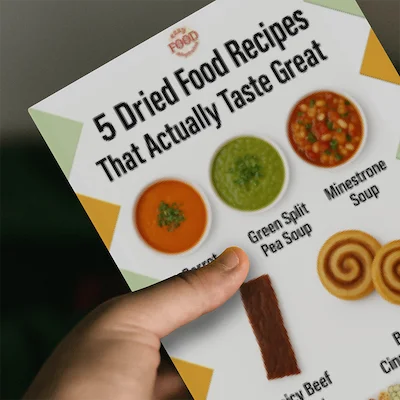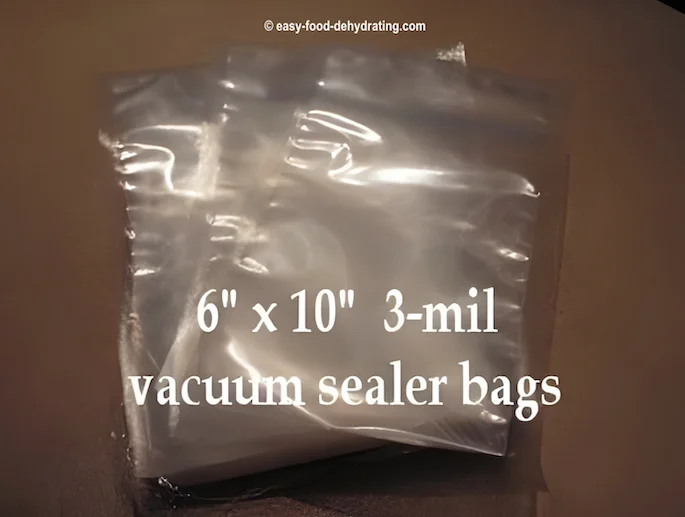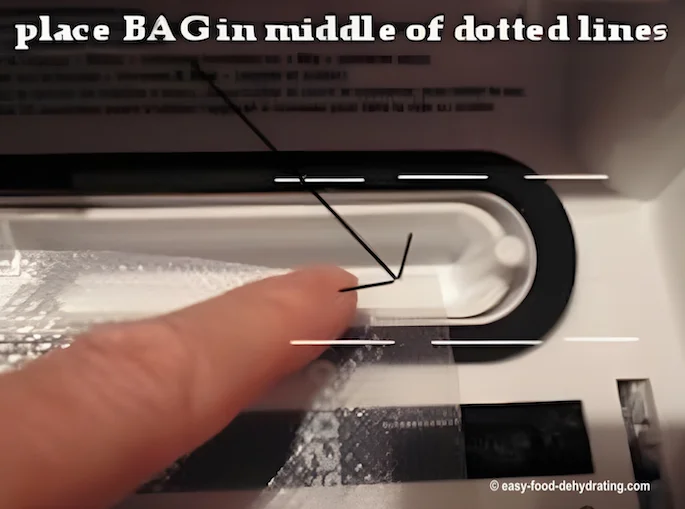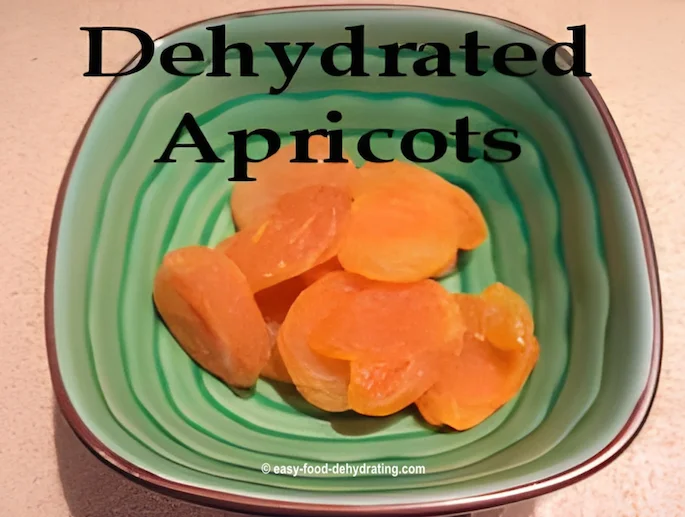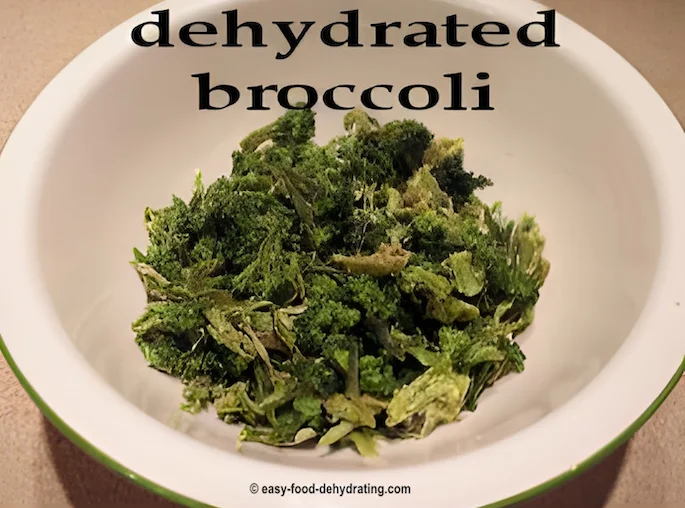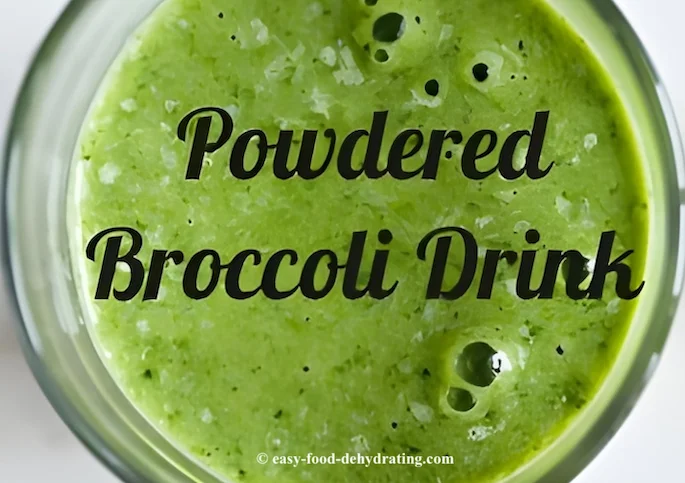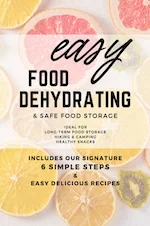Desiccant Packets for Dehydrated Food:
Your First Line of Moisture Defense

Susan Gast, Author | Blogger at Easy Food Dehydrating, Bored Boomers, Beesville Books, and A New Sober You
What Are Desiccant Packets (And Why You Can't Skip Them)
Let's learn how to use desiccant packets for dehydrated food to keep foods crisp and shelf stable — and what size to use!
When it comes to keeping your dehydrated foods in top shape, controlling moisture is just as important as getting rid of oxygen. Sure, oxygen absorbers do a great job of removing air to help prevent spoilage — but if you really want to protect your dried foods, you’ve got to tackle moisture too.

That’s where desiccant packets come in. These little guys — usually filled with silica gel — are made to soak up any extra moisture and help keep your foods dry, fresh, and mold-free. And what a good job they do. How so? They can absorb up to 40% of their weight in moisture, according to this Comprehensive Guide to Desiccant Types & Their Effectiveness report.
Quick heads-up: not all desiccant packets are safe for food! Always make sure you’re using food-grade silica gel packets. And steer clear of packets that contain cobalt chloride — it's sometimes used as a moisture indicator, but it’s toxic if accidentally ingested.
Selecting the right size of desiccant packet depends on the size of your storage container and how sensitive the dried food is to moisture. For instance, a 1-gram silica gel packet is great for containers up to about 2 quarts, while larger containers like 5-gallon buckets may require 50-gram packets—or multiple smaller ones.
How Desiccant Packets Work to Save Your Dried Foods
Keeping your dehydrated foods crisp and safe isn’t just about getting rid of oxygen — you’ve also got to fight off moisture. That’s where desiccant packets come in handy! These little packets, usually filled with silica gel, work by pulling water vapor out of the air inside your sealed containers. It's called adsorption (yes, with a 'd') because the molecules stick to the surface of the silica gel without being soaked up inside, keeping your dried foods fresh and mold-free.
When you add the right size desiccant packet to your food storage jars (Mason jars), vacuum-sealer bags, or Mylar bags, you create a dry environment that protects your food’s flavor, crunch, and shelf life. It's a simple step that makes a huge difference, especially for foods like dried fruits, veggies, jerky, and even spices.
Bear in mind that desiccant packets only handle moisture — they don't remove oxygen.
For serious long-term storage, it's smart to use both desiccant packets and oxygen absorbers together. That way, you're covering all your bases and giving your dried foods the best shot at staying fresh for months (or even years)!
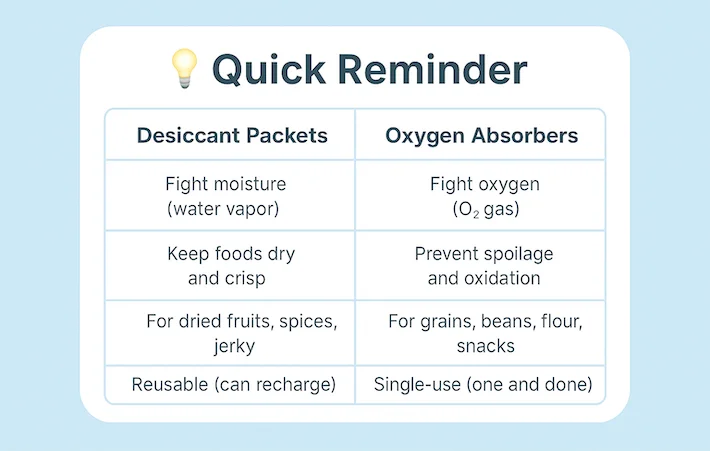
🌟 Why Desiccant Packets Don't "Soak Up" Oxygen:
- Oxygen (O₂) is a gas made of two oxygen atoms. It’s not the same as water (H₂O).
- Water vapor is water molecules floating in the air — a combo of hydrogen and oxygen atoms (H₂O).
- A desiccant packet (like silica gel) is designed to attract and hold water molecules — not oxygen molecules.
- Desiccants are very "thirsty" for moisture (water vapor), but they aren't chemically reactive to plain oxygen gas floating around.
🌟 Why This Matters:
- Oxygen absorbers (the ones filled with iron powder) are a whole different deal — they cause a chemical reaction where iron rusts (oxidizes) and uses up the oxygen inside the sealed space.
- Desiccant packets, on the other hand, just sit there quietly grabbing water vapor out of the air — they don’t react with or "soak up" oxygen itself.
A NOTE HERE about OXYGEN ABSORBERS
Use them in conjunction with Desiccant Packets.
Here's How and Why...
When to Use Desiccant Packets for Dehydrated Food — and How to Choose the Right Size
Anytime you're sealing up dehydrated foods that could soften, mold, or go stale from moisture, it's smart to toss in a desiccant packet. They're perfect for dried fruits, veggies, herbs, jerky, spices, and even homemade snacks like trail mix or crackers.
If you’re storing foods in Mason jars, vacuum-sealer bags, or Mylar bags — especially if you live in a humid area — a desiccant packet can make a huge difference in keeping everything crisp and safe for the long haul.
Choosing the right size is simple once you get the hang of it:
- Half-pint jars: Use a 1–2 gram packet
- Quart-sized jars or vacuum-sealer bags: Use a 5 gram packet
- 10"x14" Mylar bags: Use a 20–50 gram packet
- 5-gallon food-grade buckets: Use a 200–300 gram packet
And when in doubt? It's better to slightly oversize the packet than to risk too little protection. More drying power = safer food! PRINT OUT my chart (shown further down the page).
Make sure you're using food-grade silica gel packets for food storage — and double-check that they don't contain cobalt chloride (you’ll usually see a color indicator if they do, and you want to avoid that for anything touching food).
Pro Tips for Storing and Reusing Desiccant Packets
If you're using desiccant packets to protect your dehydrated foods, you’ll want to keep them in good shape so they keep doing their job. Here’s how to make the most of them:
✅ Store Extras in Airtight Containers:
Once you open a pack of fresh desiccant packets, don’t just leave the extras lying around! Seal the unused packets right away in an airtight jar, Mylar bag, or vacuum-sealer bag to stop them from grabbing moisture out of the room air.
🛠️ Pro Tip: Always have a few extra airtight jars or small vacuum bags ready for resealing unused desiccant packets. They'll stay good for months (or longer) if stored right!
✅ Watch the Color If They're Indicating Packets:
Some silica gel packets come with color indicators — usually orange to green or blue to pink — to show when they’ve absorbed all the moisture they can. If they change color, it's time to recharge or replace them.
✅ Reuse When Possible:
Good news: many desiccant packets, especially silica gel types, can be "recharged." Just bake them in the oven at 200°F (93°C) for about 1–2 hours to drive the moisture out. Let them cool completely before sealing them up again for reuse.
✅ Label Recharged Packets If Needed:
If you’re recharging in batches, you might want to label the bag with a small sticker or note so you know which ones are fresh and ready to go!
✅ Toss Packets That Look Damaged:
If a desiccant packet is torn, leaking, or smells weird, it’s best to toss it. You don't want anything questionable floating around near your stored foods.
🌟 Does a Food Vacuum Sealer Crush or Hurt Desiccant Packets?
✅ Short answer:
No, vacuum sealing generally does not crush or hurt properly made desiccant packets — especially ones filled with silica gel.
Here’s why:
-
Silica gel beads inside the packets are tiny, round, and super hard.
(Think of tiny glass beads — they don't flatten easily.) - The packet material (the fabric or paper mesh) is designed to be durable and breathable — it holds up really well to normal vacuum pressures.
- Vacuum sealing pulls air out, but it doesn't "flatten" hard solid objects the way it does soft foods. The packet may look a little thinner (because there’s no air left around it), but it won’t get crushed or damaged.
🌟 When Could a Problem Happen?
If you use really cheap or poor-quality desiccant packets, the outer packet material might tear — but that’s rare with good brands (especially food-grade ones you already recommend like Dry & Dry, Wisedry, Absorbking, etc. - see their offers below).
If you vacuum super aggressively using commercial-grade equipment (like industrial chamber sealers), it could slightly stress weaker packets — but normal countertop food sealers (like FoodSaver) are totally fine.
Where to Get Fresh, Food-Safe Desiccant Packets (Fast!)
As an Amazon Associate, I earn commission from qualifying purchases. The price you pay does not increase. Read disclosure here.
Get Your Free Moisture Control Chart (Print and Save!)
CLICK HERE
to PRINT OUT the chart below:
Just the white area is printed, not all the pink areas.
DESICCANT PACKET SIZE CHART
| Container Type | Desiccant Packet Size Needed |
|---|---|
| Half-pint jars | 1–2 gram packet |
| Quart-sized jars or vacuum-sealer bags | 5 gram packet |
| 10"x14" Mylar bags | 20–50 gram packet |
| Airtight buckets (food-grade) | 200–300 gram packet |
The recommended packet sizes depend on how much air space and humidity protection your dehydrated foods need.
★★★★★★
The page you are reading now is
ONE of the most IMPORTANT
pages on Easy Food Dehydrating
The page you
are reading now
is ONE of the most
IMPORTANT
pages on
Easy Food
Dehydrating
★★★★★★
Why is that? Well, if you're interested in storing food for the long term, make sure to add desiccant packets inside your dehydrated vacuum-sealer bags BEFORE sealing them with your FoodSaver machine or (whichever brand of vacuum-sealer you have).
Frequently Asked Questions About Desiccant Packets for Dehydrated Food
If you're serious about keeping dehydrated foods crisp and safe, knowing how to properly use desiccant packets is important.
Below, you'll find answers to the most common questions about moisture control for food storage.
What are desiccant packets?
What are desiccant packets?
Desiccant packets are small pouches filled with moisture-absorbing materials like silica gel or clay. They prevent humidity from ruining dehydrated foods, keeping everything dry and crisp.
Are desiccant packets safe for food?
Are desiccant packets safe for food?
Yes, food-grade desiccant packets are perfectly safe when used properly. Always choose packets clearly labeled as "food safe."
Can desiccant packets be reused?
Can desiccant packets be reused?
Some types, like silica gel packets, can be recharged by baking them at a low temperature to drive out moisture. Always check the manufacturer’s instructions.
When should I use desiccant packets instead of oxygen absorbers?
When should I use desiccant packets instead of oxygen absorbers?
Use desiccant packets when you're fighting moisture, not oxygen. They're great for foods that don't spoil from oxygen exposure but could go stale or clump from humidity — like dried fruits, spices, and baked goods.
How many desiccant packets do I need per container?
How many desiccant packets do I need per container?
It depends on container size and humidity levels. As a rough guide:
- Small jar: 1 gram packet
- Quart-size bag: 5 gram packet
- 5-gallon bucket: 200+ gram packet
See my printable quick-reference chart you can print out, shown earlier on the page.
Thanks for stopping by to learn about desiccant packets for dehydrated food usage.
I hope this guide helped you feel confident about using desiccant packets to keep your dried foods crisp, safe, and delicious.
Happy dehydrating!
Grab 5 Dried Food Recipes You'll Actually Love
Don't forget to grab a copy of our all new
5 Dried Food Recipes (That Actually Taste Great)
They're my all-time favorite easy dried food meals!
Get it here right now.
For Free!
Before You Go...
If you like the content, please give me some love by clicking on the 🩷 in the lower right-hand corner (on just about all my pages). This signals to me that you find it enjoyable and useful.
And don’t forget to grab your FREE 5 Dried Food Recipes via the opt-in form — they're waiting for you! Thank you so much! (Get it here).










